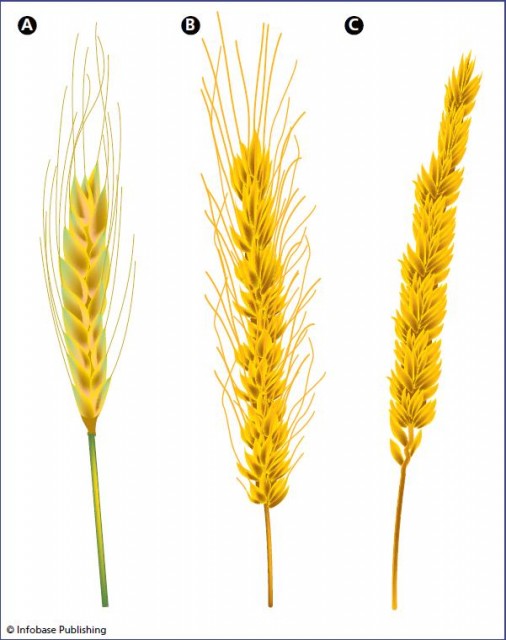The Story of Wheat
Wheat is a type of grass that grows wild in the mountains of southeastern Turkey, and it was there, about 11,000 or possibly as much as 12,500 years ago, that people began to cultivate it. They had been collecting wheat grain from time immemorial, preferring einkorn (Triticum monococcum) and emmer (T. turgidum) wheats, but they faced a problem. Dense though the stands of these wheats were—and still are—it was impossible to avoid losing much of the grain. In all cereals, the grains are the plants' seeds, and when the ears are ripe wild plants shed the seeds spontaneously, so they fall to the ground where they are able to germinate. Once on the ground, however, most of the wild grain was lost to the human communities that depended on it. So people harvested the crop before it shed its seeds and threshed the plants to remove the seeds in a place where they could be swept up. It meant that many of the ears were not quite ripe, but at least the grains were not lost.
Cereal grains are attached to the shaft of the ear, called the rachis. When the grains are ripe the rachis becomes brittle and breaks, allowing the grains to fall. Among the wild plants that people collected there were some in which the grains were ripe but the rachis had failed to break. After a time people began to plant some of the seeds they had collected and harvested a crop they had cultivated. This was the beginning of domestication, and it had several consequences that archaeobotanists—botanists who study plant remains recovered from archaeological sites—are able to recognize.
When a cereal seed is shed naturally, it bears a neat, round scar at the point where it detached from the rachis. If the seed was harvested while still attached to the plant and separated by threshing before the rachis became brittle, fracturing of the rachis produces a rougher scar. This allows archaeobotanists to distinguish wild from domesticated grains.

Wild cereal seeds possess hooks that curl and straighten in response to being wetted and dried. When they reach the ground this movement makes them drag themselves beneath the soil surface. This hides them from seed-eating birds and mammals and provides them with suitable conditions for germination. Seeds of domesticated cereals lack these hooks.
A cereal seed contains endosperm—a store of food to sustain the young plant until it is able to fend for itself. Wild seeds germinate very close to the soil surface, so the emerging shoots have only a short distance to grow before they are exposed to sunlight and commence photosynthesis. Consequently, the seeds require only a small amount of endosperm. Farmers sow the seeds much deeper in the soil. This means that only the largest seeds, with the most endosperm, are likely to survive. Domestication produces larger grains.
Early farmers were inadvertently selecting the traits that over many generations led to the cultivated wheat varieties grown today. They selected plants that produced large seeds and, more important, plants with tough rachises that did not shed their seeds as soon as they ripened. A single genetic mutation makes the difference between a brittle rachis and a tough one. Natural selection favors the brittle rachis, because it allows the plant to release its seeds. Artificial selection by farmers favored the tough rachis, because it allowed the grain to be harvested. The farmers won, but in doing so they produced cereals that were entirely dependent on humans because they were unable to propagate efficiently. The following illustration compares einkorn wheat with two varieties of modern bread wheat (T. aestivum), one with awns—long bristles that protrude from the grains—and one without.
The transformation of wild wheats into modern domesticated wheats was far from straightforward, and it involved several wheat species and related grasses. Nor did it happen quickly. For a long time farmers would have had no way to prevent wild cereals from growing among their cultivated crops and hybridizing with them. Perhaps the wild plants periodically overwhelmed the cultivated ones. When the climate was favorable and the wild cereal stands flourished, communities might have abandoned farming and all the hard work it entailed, preferring to go out with their stone-bladed sickles and gather their food until weather conditions deteriorated and they resumed cultivation.
After such a vast expanse of time, no one can tell. What archaeobotanists do know, however, is that it took thousands of years to domesticate wheat. From the time that grains with a tough rachis first appeared, it was more than 3,000 years before this mutation came to predominate, showing that the domestication process was complete.
- The Origins of Agriculture
- Carl Skottsberg and the Plants of Southern South America
- August Grisebach and Floral Provinces
- Edward Forbes and the Significance of Ice Ages
- Alphonse de Candolle and Why Plants Grow Where They Do
- Franz Meyen and Vegetation Regions
- Karl Ludwig von Willdenow and the Start of Scientific Plant Geography
- Alexander von Humboldt and the Plants of South America
- Ernest Wilson, Collecting in China and Japan